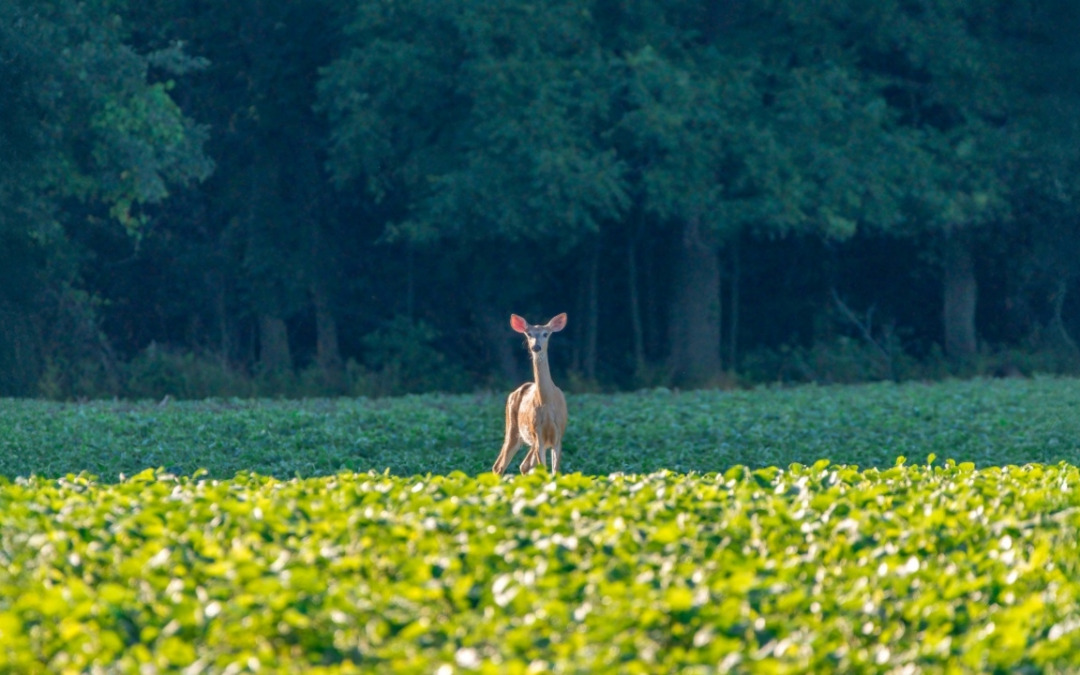When can there be too many deer even for a hunting enthusiast? When that same enthusiast is a row-crop farmer, and the deer are using their fields as an all-you-can-eat buffet.
While deer grazing on crops has been a consistent problem for decades, it has escalated in the past 10 years and become a dire issue for farmers who are already working with thin profit margins, said Jenny Koebernick, associate professor in the Auburn University College of Agriculture’s Department of Crop, Soil and Environmental Sciences and a researcher with the Alabama Agricultural Experiment Station.
“The deer tend to graze the crop at various stages, but the most damaging is right at emergence,” she said. “As the plant comes out of the ground, it is the most vulnerable and not large enough to survive most stresses.”
This is why all seed has some sort of seed treatment to protect against diseases and pests such as insects or nematodes, Koebernick said.
“When the deer eat it at the cotyledon (first-leaf) stage, the plant will not grow back,” she said. “The cost of a bag of seed has reached upwards of $900 for some cotton cultivars, so if a grower misses his planting window, he is guaranteed yield losses. If a deer eats the late-planted crop, any chances of making a profit are diminished.”
While this stage of deer feeding is the hardest on the crop and grower, feeding happens throughout the crop season, Koebernick said, cutting into the yields of cotton, soybean, sorghum, peanuts and corn.
“Once the plant gets older, it can sustain the occasional browsing, but it is extremely aggravating for farmers to watch their crop being consumed when they have spent so much time and effort protecting and managing it from other environmental factors,” she said.
This problem has been reported from all regions of Alabama and in all crops, with soybean growers tending to replant the most.
“The reported deer population in the state is 30 deer per square mile, but most farmers would be quick to dispute that claim,” Koebernick said. “Many are reporting upwards of 50 deer in a field grazing at a given time. Growers also are trying to reduce the population through the appropriate means of depredation permits for hunting, but this can be a challenge in itself.”
Some farmers have used repellants on their crops to reduce deer feeding. Many times, these repellants have not been independently evaluated, and the claims made by manufacturers are not consistently realized by the farmers, she said
They can also be messy, with some consisting of sheep fat or elk blood, which can often clog up the sprayers, resulting in lost time and energy, she added.
“Typically, deer may be deterred for a short period of time, but as the deer population has risen, there are fewer sources of food,” Koebernick said. “While they might not want to eat the crop with a repellent, it doesn’t keep them away for long. Farmers have reported that a repellent may work one year but not the next time they try it, so the claims are short lived, and not everyone will have the same experience.
“In addition, repellents are expensive, with some growers spending as much as $32 per acre for the product itself and paying someone to apply it to the crop. As of last year, there was not anyone in Alabama doing research on these repellents as regards to proper rates, different types and efficacy.”
However, there are some plants that deer just won’t eat, and this opens an entirely new line of inquiry, she said.
“What makes a deer choose one variety or plant over the other to eat? What do they like? What do they dislike? There was a time when deer did not eat cotton,” Koebernick said. “Cultivar differences have not been properly researched. Old cultivars referred to as varieties differ significantly in a range of metabolites and have a greater amount of genetic diversity. Are there any older varieties that a deer will not eat, and if so, can we determine the mechanism and capitalize on it? There are a lot of factors to consider.”
Koebernick has joined with a group of her colleagues to investigate a range of crop management strategies to mitigate deer feeding, including cover/winter crop choice, repellents, scare devices and varietal differences.
Studies were initiated this year at the Experiment Station’s Piedmont Research Unit in Camp Hill, which has a reported 150 deer per square mile. There are two 1-acre blocks surrounded by 8-foot deer fencing with a series of six gates, which can control the movement of the deer.
In one trial, three repellents were tested on one soybean variety. The products were applied on soybean foliage at early stages and as a control on whole corn kernels. Two tests were performed on soybeans on June 3 and Aug. 2. The first test showed that 15%, 33%, 5% and 57% of soybean plants were damaged after being treated with repellents or left untreaded (control), respectively. In the second test, 13%, 5%, 10%, and 32% of the plants were damaged, respectively.
Spraying the same products on whole corn kernels showed that all three products helped prevent deer feeding for the first 48 hours post-treatment while only one prevented deer feeding after 96 hours after treatment. Treatments consisted of 10 pounds of whole corn in open trays replicated three times.
For cotton, 38 cultivars were planted in a randomized complete block experimental design with four replications. The plots were four 20-foot rows. At the fourth true leaf, the gates were opened to allow the deer to graze. Every 24 hours, observations were made to determine preference. All cultivars grown in the trial were eaten to the ground by mid-August.
“The 38 cultivars used were primarily commercially available cultivars,” Koebernick said. “A seed increase of a range of varieties are currently being grown in the greenhouse to produce enough seed to do a more focused trial next year. This year was a learning curve as to what to expect. We will adjust moving forward.”
One management strategy next year will be to plant wheat this winter that have awns, she said.
“It has been reported that deer tend to stay away from these types. The awns are a spikelet that will poke the deer’s face/eyes. We are working on the proper timing to plant into the wheat to protect the main cotton crop in the seedling stage. Regional Extension Agent Eddie McGriff also will be doing a similar type of management strategy on a couple of grower farms.”
In addition, Koebernick has both a cotton and soybean diversity panel that consists of more than 300 different varieties for both crops.
“This 2024 season, I planted the cotton one and am testing for sugar content and gossypol content in the leaves to determine a range,” she said. “Gossypol is a natural defense mechanism in cotton that prevents small mammals from feeding on it. In addition, deer are attracted to plants with high sugar content. The varieties with the lowest and highest content of both will be identified and used in future feeding studies.”
These projects are currently funded through the Alabama Cotton Commission, Alabama Soybean Producers Association and Cotton Inc. A larger effort is forming in states where damage is being reported on most crop land and where smaller farm sizes are surrounded by wooded areas.





